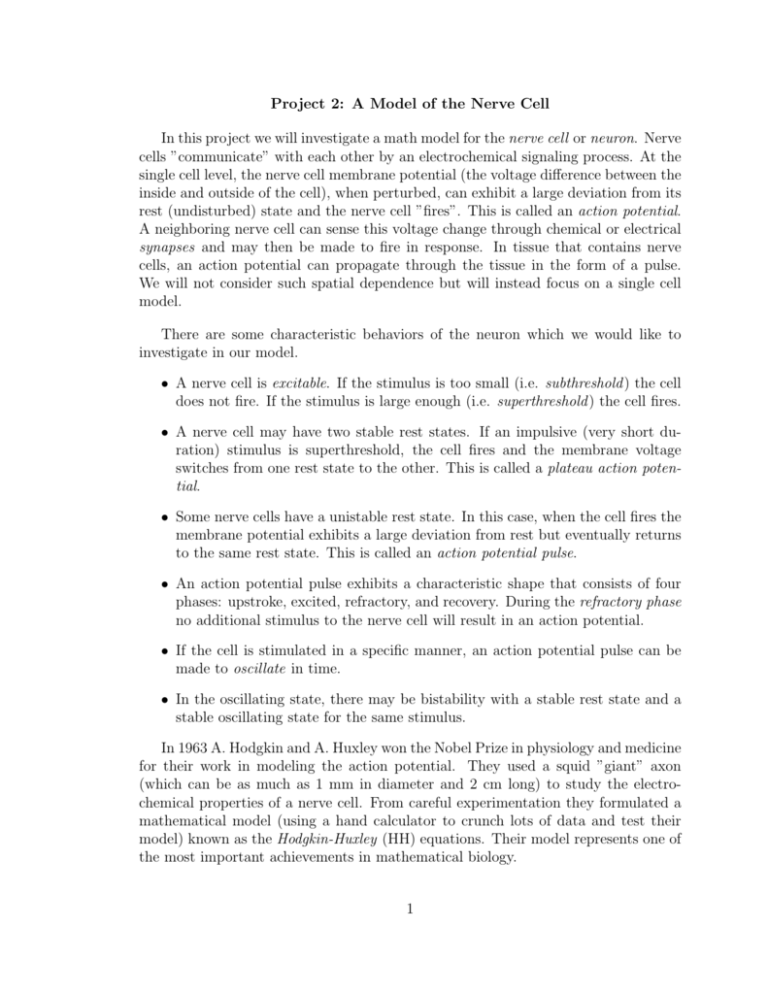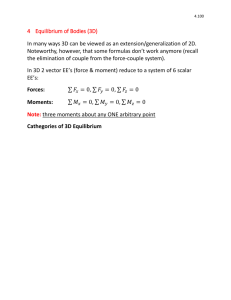Project 2: A Model of the Nerve Cell In this project we will investigate
advertisement

Project 2: A Model of the Nerve Cell In this project we will investigate a math model for the nerve cell or neuron. Nerve cells ”communicate” with each other by an electrochemical signaling process. At the single cell level, the nerve cell membrane potential (the voltage difference between the inside and outside of the cell), when perturbed, can exhibit a large deviation from its rest (undisturbed) state and the nerve cell ”fires”. This is called an action potential. A neighboring nerve cell can sense this voltage change through chemical or electrical synapses and may then be made to fire in response. In tissue that contains nerve cells, an action potential can propagate through the tissue in the form of a pulse. We will not consider such spatial dependence but will instead focus on a single cell model. There are some characteristic behaviors of the neuron which we would like to investigate in our model. • A nerve cell is excitable. If the stimulus is too small (i.e. subthreshold ) the cell does not fire. If the stimulus is large enough (i.e. superthreshold ) the cell fires. • A nerve cell may have two stable rest states. If an impulsive (very short duration) stimulus is superthreshold, the cell fires and the membrane voltage switches from one rest state to the other. This is called a plateau action potential. • Some nerve cells have a unistable rest state. In this case, when the cell fires the membrane potential exhibits a large deviation from rest but eventually returns to the same rest state. This is called an action potential pulse. • An action potential pulse exhibits a characteristic shape that consists of four phases: upstroke, excited, refractory, and recovery. During the refractory phase no additional stimulus to the nerve cell will result in an action potential. • If the cell is stimulated in a specific manner, an action potential pulse can be made to oscillate in time. • In the oscillating state, there may be bistability with a stable rest state and a stable oscillating state for the same stimulus. In 1963 A. Hodgkin and A. Huxley won the Nobel Prize in physiology and medicine for their work in modeling the action potential. They used a squid ”giant” axon (which can be as much as 1 mm in diameter and 2 cm long) to study the electrochemical properties of a nerve cell. From careful experimentation they formulated a mathematical model (using a hand calculator to crunch lots of data and test their model) known as the Hodgkin-Huxley (HH) equations. Their model represents one of the most important achievements in mathematical biology. 1 R. Fitzhugh proposed a simplified system which retained the basic qualitative behavior of the HH equations. J. Nagumo, a Japanese electrical engineer, built an electrical circuit that modeled the behavior of the HH equations. The system that we will study is the FitzHugh-Nagumo (FHN) equations. The FHN equations are a nonlinear 2-dimensional system. They are expressed as follows. v̇ = f (v) − w, ẇ = (v − γw) . (1) The function f (v) is cubic f (v) = −v(1 − v)(µ − v). The variable v represents the nerve cell membrane voltage and w represents various transmembrane electrical currents. It is important to realize that this is a nondimensionalized system. This means that the original equations have been scaled so as to make v and w dimensionless. We are mostly concerned with the qualitative analysis of these equations rather than being quantitatively accurate with regards to units. We will consider positive and 0 < µ < 1 to be fixed. The positive constant γ will take different values. 1. Determine the ranges of γ so that (1) has exactly one equilibrium or exactly three equilibria. Your answer should be expressed in terms of µ. In the case of three equilibria, compute the two nonzero equilibrium solutions (v, w). Unless otherwise indicated, for the remainder of this project set = 0.008 and µ = 0.139. (2) For any of the plots that you perform in pplane, set the solver option to ode23s and integrate forwards only. 2. The resting potential of a nerve cell can be bistable (i.e. there are two different stable rest states). The membrane potential can be ”switched” between the stable rest states by a superthreshold voltage perburbation. This is the plateau action potential. (a) Let γ = 8 for the remainder of question 2. Verify from the results in question 1 that there are three equilibrium solutions. Compute all of the equilibria. Use pplane to plot the nullclines and equilibrium solutions and verify your numerical computations. In your plot clearly show the cubic nullcline maximum/minimum and the intersections of the nullclines. 2 (b) Let (v̂, ŵ) denote a particular equilibrium. Linearize (1) about (v̂, ŵ) and derive a general expression for the eigenvalues of the linearized system. Use the values from part (a) to classify each equilibrium as a saddle point, nodal/spiral sink, or nodal/spiral source and specify the stability properties of each equilibrium. Verify your results using pplane and plotting trajectories in the phase plane for each equilibrium. (c) The linearization in part (b) shows that one of the equilibria is a saddle point. Compute the eigenvectors for the linearized system at this equilibrium. Print a plot of the equilibrium in the phase plane (without the nullclines) and sketch the eigenvectors in the plot. Use pplane to plot the linearized system and verify your results. (d) Show that the equilibrium (0, 0) is ”excitable” and can be ”switched” to the other stable equilibrium as follows. Fix w = 0 and introduce small positive perturbations in v away from v = 0. There is some value v = vT so that the system’s trajectory will return to (0, 0) if v < vT and but not if v > vT . What happens when v > vT ? The value vT is called a threshold value. Use keyboard input of initial conditions to estimate vT to 5 decimal places. Provide two plots of v and w vs. t which show subthreshold (no switching) and superthreshold (switching) behavior. For the remainder of the project, let γ = 2.54. In this case, there is a unique equilibrium solution of the FHN equations. A superthreshold perturbation of v will result in an action potential pulse. 3. (a) Use pplane to plot the the nullclines and the equilibrium solution. Is this equilibrium stable or unstable? In your plot clearly show the intersections of the nullclines. Compare this plot with the plot from question 2(a) and explain how changing the value of γ produced a change in the number of equilibrium solutions. (b) Show that the equilibrium (0, 0) is ”excitable”. Repeat the method of question 2(d) to find a threshold value vT . Does the threshold value appear to be the same as in question 2(d)? Provide three plots: (i) v and w vs. t which shows subthreshold response (ii) v and w vs. t which shows subthreshold response (iii) phase-plane plot with both subthreshold and superthreshold responses 4. We now introduce a constant stimulus term I ≥ 0 so that the equations (1) are v̇ = f (v) − w + I, ẇ = (v − γw) . (3) I represents an applied current stimulus that is turned on at t = 0 and held constant. Mathematically, I is a bifurcation parameter. As I is varied, the qualitative nature of the solutions change. We know (from question 3) how the 3 solutions behave when I = 0. We want to investigate the nature of the solutions for positive I. (a) The equilibrium solutions depend on I. For example, when I = 0, (0, 0) is an equilibrium solution. Use the graphs of the nullclines to explain why there is a unique equilibrium solution for each value of I ≥ 0. Support your explanation by showing that the v component of the equilibrium solutions are defined by an equation of the form fs (v) = I. Here fs (v) is a cubic function of v. Use calculus to show that fs is a one-to-one function and conclude that the equilibrium solutions have v component v = fs−1 (I). What is the w component? (b) Denote the equilibrium solution that corresponds to I as (vI , wI ). Linearize (3) about (vI , wI ) and use the trace-determinant plane of the linearized system to classify the equilibrium solutions as I is varied. State the intervals of I in which the equilibrium solutions are saddle points, nodal/spiral sinks, and nodal/spiral sources and specify the stablity of the equilibria in each of the intervals. (c) Use pplane and provide phase-plane plots of solutions to the equations for I = 0.04, 0.09, 0.13, 0.18, 0.24. Include the nullclines and equilibrium points in your plots. For each plot use initial conditions that are close to the equilibrium with a small perturbation in the v component. Are these plots consistent with your results from part (b)? Describe any interesting or unexpected behavior in the solutions. (d) Some values of I in part (d) result in oscillating solutions. In the phase plane, these are called limit cycles. What do you observe with regards to the equilibria that correspond to these particular I values? For the oscillating solutions from part (d) provide a plot with both v and w vs. t on the same graph and estimate the amplitude, average value, and period. Describe the general behavior of these properties with regards to their dependence on I. (e) Bifurcation values of I are the values at which the equilibrium solutions change from stable to unstable. For the system (3) when an equilibrium changes from stable to unstable the observed solutions are periodic. This is called a Hopf bifurcation. In general, the critical values of I at a Hopf bifurcation must correspond to pure imaginary eigenvalues in the linearized system (that is, when the equilibrium is a center for the linearized system). ± ± Denote these values IH . From your analysis in part (c), determine IH and the corresponding (vI , wI ). Try to verify your results using pplane. 4 − + (f) For I < IH and I > IH there is bistability in the system: a stable equilibrium solution and a stable periodic solution exist for the same value of I. Use pplane to find one value of I in each of these bistable regions and plot the results in the phase plane. Plot both the stable equilibrium and the stable oscillating solution in the same plot. Note: I must be very close to − + either IH or IH in order to find these bistable solutions. 5. Give a brief summary of your investigations which explains why the FHN equations (1) and (3) provide a good model of a nerve cell. question (a) 1 2 3 4 5 style 6 6 10 (b) (c) (d) (e) (f) total 6 6 10 6 6 6 6 6 6 6 6 24 12 44 6 8 6 5







